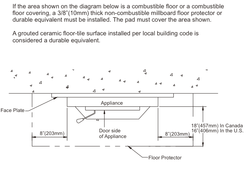Hi,
I had a Lopi Freedom Bay insert installed in my masonry fireplace a few years ago. The house is about 60 years old and the hearth is level with the floor. I’ve never had a problem but have always been concerned about the hearth extension.
The Freedom Bay sticks out onto the hearth extension about 4.5”. The extension is mortar about 3” thick and supported with ¾” wood boards as can be seen from the basement.
I always wondered if there is a clearance to combustibles issue with this set up. The owners manual doesn’t specify a minimum hearth extension thickness or R value other than it should be non-combustible and at least about 0.018” thick. The diagrams show the hearth extension to be that portion beyond the fireplace opening. It doesn’t show that it’s only that portion beyond the face of the insert opening.
So are they saying it’s ok for the 4.5” of the insert that sticks out can rest on wood flooring if there is a piece of sheet metal protecting it? Seems insufficient but it’s what it says. If that set up is approved then I should be in good shape.
By the way, the Freedom bay’s combustion chamber is about 1.5” above the insert floor to allow air movement around the firebox. But the insert floor does get very hot. The wood framing in the basement only ever got warm to the touch. I drilled a small hole in the framing so I could feel if the masonry hearth extension bottom ever got hot. It never really did except for one time it got hot.
The dealer did the pre site visit and the install. I called the manufacturer a while ago but never was able to talk to the right people. They couldn’t clarify things but kept saying it needs to be installed in an approved masonry fireplace.
I know we all have our opinions about this. Seems like an insuffiecint set up, but anyone know about the specs? Thanks.
I had a Lopi Freedom Bay insert installed in my masonry fireplace a few years ago. The house is about 60 years old and the hearth is level with the floor. I’ve never had a problem but have always been concerned about the hearth extension.
The Freedom Bay sticks out onto the hearth extension about 4.5”. The extension is mortar about 3” thick and supported with ¾” wood boards as can be seen from the basement.
I always wondered if there is a clearance to combustibles issue with this set up. The owners manual doesn’t specify a minimum hearth extension thickness or R value other than it should be non-combustible and at least about 0.018” thick. The diagrams show the hearth extension to be that portion beyond the fireplace opening. It doesn’t show that it’s only that portion beyond the face of the insert opening.
So are they saying it’s ok for the 4.5” of the insert that sticks out can rest on wood flooring if there is a piece of sheet metal protecting it? Seems insufficient but it’s what it says. If that set up is approved then I should be in good shape.
By the way, the Freedom bay’s combustion chamber is about 1.5” above the insert floor to allow air movement around the firebox. But the insert floor does get very hot. The wood framing in the basement only ever got warm to the touch. I drilled a small hole in the framing so I could feel if the masonry hearth extension bottom ever got hot. It never really did except for one time it got hot.
The dealer did the pre site visit and the install. I called the manufacturer a while ago but never was able to talk to the right people. They couldn’t clarify things but kept saying it needs to be installed in an approved masonry fireplace.
I know we all have our opinions about this. Seems like an insuffiecint set up, but anyone know about the specs? Thanks.


